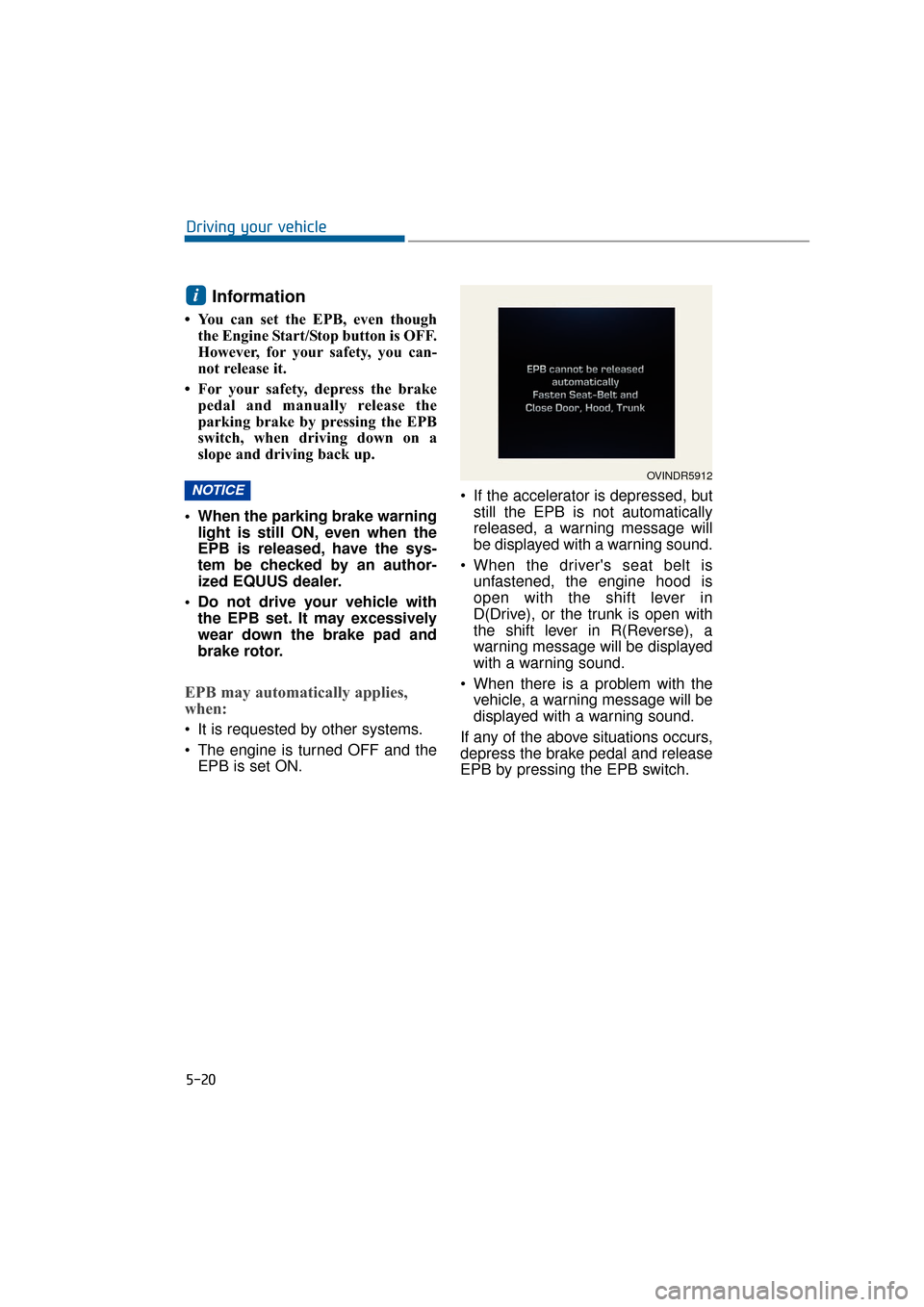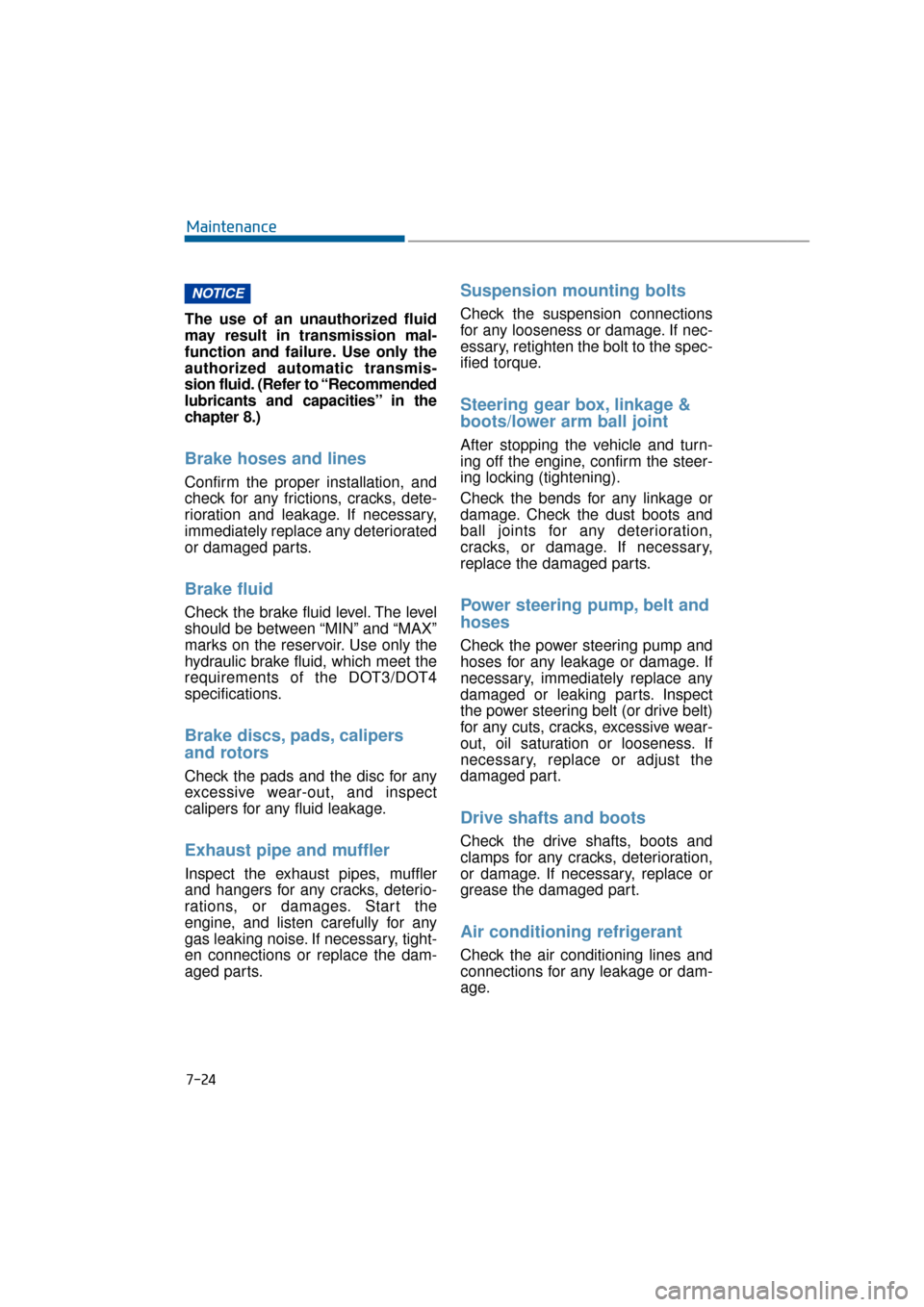brake rotor Hyundai Equus 2016 Owner's Manual
[x] Cancel search | Manufacturer: HYUNDAI, Model Year: 2016, Model line: Equus, Model: Hyundai Equus 2016Pages: 477, PDF Size: 16.25 MB
Page 271 of 477

Information
• You can set the EPB, even thoughthe Engine Start/Stop button is OFF.
However, for your safety, you can-
not release it.
• For your safety, depress the brake pedal and manually release the
parking brake by pressing the EPB
switch, when driving down on a
slope and driving back up.
When the parking brake warning light is still ON, even when the
EPB is released, have the sys-
tem be checked by an author-
ized EQUUS dealer.
Do not drive your vehicle with the EPB set. It may excessively
wear down the brake pad and
brake rotor.
EPB may automatically applies,
when:
It is requested by other systems.
The engine is turned OFF and theEPB is set ON. If the accelerator is depressed, but
still the EPB is not automatically
released, a warning message will
be displayed with a warning sound.
When the driver's seat belt is unfastened, the engine hood is
open with the shift lever in
D(Drive), or the trunk is open with
the shift lever in R(Reverse), a
warning message will be displayed
with a warning sound.
When there is a problem with the vehicle, a warning message will be
displayed with a warning sound.
If any of the above situations occurs,
depress the brake pedal and release
EPB by pressing the EPB switch.
NOTICE
i
5-20
Driving your vehicle
OVINDR5912
Page 381 of 477

7-24
Maintenance
The use of an unauthorized fluid
may result in transmission mal-
function and failure. Use only the
authorized automatic transmis-
sion fluid. (Refer to “Recommended
lubricants and capacities” in the
chapter 8.)
Brake hoses and lines
Confirm the proper installation, and
check for any frictions, cracks, dete-
rioration and leakage. If necessary,
immediately replace any deteriorated
or damaged parts.
Brake fluid
Check the brake fluid level. The level
should be between “MIN” and “MAX”
marks on the reservoir. Use only the
hydraulic brake fluid, which meet the
requirements of the DOT3/DOT4
specifications.
Brake discs, pads, calipers
and rotors
Check the pads and the disc for any
excessive wear-out, and inspect
calipers for any fluid leakage.
Exhaust pipe and muffler
Inspect the exhaust pipes, muffler
and hangers for any cracks, deterio-
rations, or damages. Start the
engine, and listen carefully for any
gas leaking noise. If necessary, tight-
en connections or replace the dam-
aged parts.
Suspension mounting bolts
Check the suspension connections
for any looseness or damage. If nec-
essary, retighten the bolt to the spec-
ified torque.
Steering gear box, linkage &
boots/lower arm ball joint
After stopping the vehicle and turn-
ing off the engine, confirm the steer-
ing locking (tightening).
Check the bends for any linkage or
damage. Check the dust boots and
ball joints for any deterioration,
cracks, or damage. If necessary,
replace the damaged parts.
Power steering pump, belt and
hoses
Check the power steering pump and
hoses for any leakage or damage. If
necessary, immediately replace any
damaged or leaking parts. Inspect
the power steering belt (or drive belt)
for any cuts, cracks, excessive wear-
out, oil saturation or looseness. If
necessary, replace or adjust the
damaged part.
Drive shafts and boots
Check the drive shafts, boots and
clamps for any cracks, deterioration,
or damage. If necessary, replace or
grease the damaged part.
Air conditioning refrigerant
Check the air conditioning lines and
connections for any leakage or dam-
age.
NOTICE